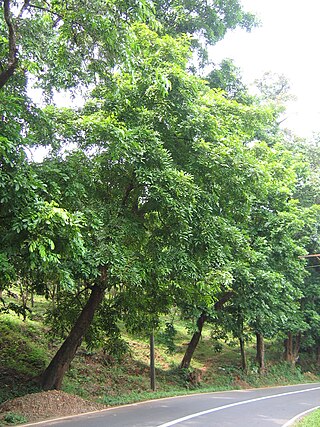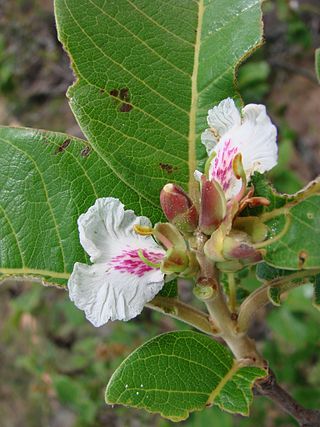
Pterocarpus is a pantropical tree genus in the Fabaceae family. It belongs to the subfamily Faboideae, and was recently assigned to the informal monophyletic Pterocarpus clade within the Dalbergieae. Most species of Pterocarpus yield valuable timber traded as padauk, usually pronounced or ; other common names are mukwa or narra.

The family Cisticolidae is a group of about 160 warblers, small passerine birds found mainly in warmer southern regions of the Old World. They were formerly included within the Old World warbler family Sylviidae.

Brachystegia is a genus of tree of the subfamily Detarioideae that is native to tropical Africa.

Sesbania is a genus of flowering plants in the pea family, Fabaceae, and the only genus found in tribe Sesbanieae. Riverhemp is a common name for plants in this genus. Notable species include the rattlebox, spiny sesbania, and Sesbania sesban, which is used in cooking. Plants of this genus, some of which are aquatic, can be used in alley cropping to increase the soil's nitrogen content. The species of rhizobia responsible for nitrogen fixation in Sesbania rostrata is Azorhizobium caulinodans.

The plant tribe Phaseoleae is one of the subdivisions of the legume subfamily Faboideae, in the unranked NPAAA clade. This group includes many of the beans cultivated for human and animal food, most importantly from the genera Glycine, Phaseolus, and Vigna.

Brosimum is a genus of plants in the family Moraceae, native to tropical regions of the Americas.
Stuhlmannia moavi is a species of flowering plants in the legume family, Fabaceae. It is the only species in the genus Stuhlmannia. It is a tree native to Kenya, Tanzania, and Madagascar, where it grows in seasonally-dry tropical forest, woodland on limestone, and in riverine forest. The genus belongs to tribe Caesalpinieae in subfamily Caesalpinioideae.
Angylocalyx is a genus of flowering plants in the family Fabaceae. It includes seven species native to sub-Saharan Africa, ranging from Guinea to Angola, Tanzania, and Kenya.

Schefflerodendron is a genus of flowering plants in the family Fabaceae. It includes four species of trees native to tropical Africa, ranging from Cameroon to Tanzania and Angola. They grow in tropical rain forest and seasonally-dry forest, including disturbed areas. Three species are native to the Guineo-Congolian forests of west-central Africa, and one species also extends to the Zanzibar-Inhambane coastal forests of Tanzania.

Xylia is a genus of flowering plants in the family Fabaceae. It is native to Sub-Saharan Africa, South Asia, and Mainland Southeast Asia.
Zenkerella is a genus of plants in the family Fabaceae. It includes six species of evergreen trees native to tropical Africa. One species is native to Nigeria, Cameroon, and Gabon in west-central tropical Africa, where it grows in lowland, riverine, or swamp Guineo-Congolian forest. The other five species grow in Afromontane or coastal Zanzibar–Inhambane forest in Tanzania.

The grey-capped warbler is a species of bird in the family Cisticolidae. It is monotypic in the genus Eminia. The grey-capped warbler is found in Burundi, Democratic Republic of the Congo, Kenya, Rwanda, South Sudan, Tanzania, and Uganda. It is a large, chunky, thin-tailed-warbler with a distinctive grey cap, a black band around its head, and a chestnut throat wrapping its neck. Grey-capped warblers maintain a diet of insects and other invertebrates, including caterpillars, moths, grasshoppers, and mantids.

Mezilaurus is a genus of plant in the family Lauraceae. It is a neotropical genus consisting of 18-27 species, mostly hardwood evergreen trees, occurring from Costa Rica to the southeast of Brazil. Thirteen species have been identified in Brazil, distributed mostly in the Amazon region. In Rio de Janeiro state only M. navalium (Allemão) Taub. ex Mez has been recorded. Some species have been reported within the Cerrado and in semideciduous forest surrounding the Pantanal Matogrossense. The name Mezilaurus refers to its similar appearance to the genus Laurus.

Qualea is a flowering plant genus in the family Vochysiaceae. These plants occur in the Neotropics and their wood makes good timber and firewood and is used in construction. Some species of Qualea have medicinal properties.

Peltophorum is a genus of 5–15 species of flowering plants in the family Fabaceae, subfamily Caesalpinioideae. The genus is native to certain tropical regions across the world, including northern South America, central and southern Africa, Indochina, southeastern China, Malesia, New Guinea, and northern Australia. The species are medium-sized to large trees growing up to 15–25 m tall, rarely 50 m.

Aeschynomene is a genus of flowering plants in the family Fabaceae, and was recently assigned to the informal monophyletic Dalbergia clade of the Dalbergieae. They are known commonly as jointvetches. They range across tropical and subtropical regions of the Americas, sub-Saharan Africa, south, southeast, and east Asia, and Australia. These legumes are most common in warm regions and many species are aquatic.

Xylia xylocarpa is a species of tree in the mimosoid clade of the subfamily Caesalpinioideae of the family Fabaceae.

Platysepalum is a genus of flowering plants in the family Fabaceae. It includes 13 species of small trees, shrubs, or lianas native to tropical Africa, from Senegal to Tanzania and south to Angola and Mozambique. Most species are native to the Guineo-Congolian forests of west and west-central Africa, and one is native to the tropical Zanzibar-Inhambane coastal forests of Africa's eastern coast. Habitats include tropical rain forest and seasonally-dry lowland forests, often in disturbed areas. It belongs to subfamily Faboideae.

Anonychium is a genus of plant in the pea family (Fabaceae). It includes a single species, Anonychium africanum, a tree native to northern Sub-saharan Africa from Mauritania to Uganda and to Saudi Arabia. It is known by the synonym Prosopis africana, and its common names include African mesquite, iron tree, gele, okpehe, and somb tree. Okpehe is the name given by the Idoma and Igala people of Nigeria to both the tree and its fermented seeds. All of the other derivatives such as okpeye and okpiye stem from the noun okpehe used by the Idoma and Igala people of present day Benue State of Nigeria.
Goyazia is a genus of flowering plants belonging to the family Gesneriaceae.















